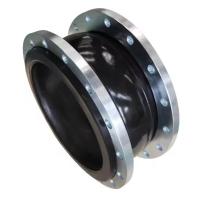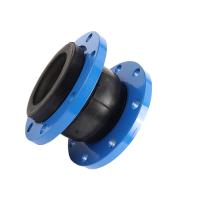ANSI Standard Flange Rubber Expansion Joint Shock Absorber for
Pipeline
The single-ball rubber joint is a highly elastic and airtight pipe
connection component. It consists of a rubber ball with an inner
rubber layer, a reinforcement layer, and an outer rubber layer, and
a loose metal flange.
It is widely used in various piping systems, effectively absorbing
vibration and noise, compensating for thermal expansion and
contraction caused by temperature changes, and allowing a certain
degree of deflection.

Rubber Material Selection Guide
Natural Rubber (NR): Suitable for ordinary water and air media, temperature range -20°C
to +80°C
Ethylene Propylene Diene Monomer (EPDM): High-temperature and ozone-resistant, suitable for hot water and
steam media
Nitrile Butadiene Rubber (NBR): Excellent oil resistance, suitable for oil-based media
Chloroprene Rubber (CR): Excellent weather resistance, suitable for outdoor environments

Application Scenario Details
Chemical Piping Systems
In acid and alkaline media transport pipelines, a Teflon-coated
lining design, combined with corrosion-resistant rubber,
effectively resists chemical corrosion. After use at a Guangxi
chemical company, pipeline leakage rates were reduced by 95%.
HVAC Systems
EPDM connectors, designed specifically for high-temperature hot
water, have operated continuously in an 85°C circulating hot water
system for three years without signs of aging. The
vibration-damping effect reduces pump noise by 15 decibels.
Water Supply and Drainage Engineering
Large-diameter DN1200 connectors are used in urban water supply
systems, successfully compensating for 25mm displacement caused by
foundation settlement and preventing pipe ruptures.


Professional Installation Steps
Pre-installation Inspection: Confirm that the flange sealing
surface is flat and undamaged, and that the bolt holes are aligned.
Precise Positioning: Use a dedicated positioning tool to ensure
concentricity between the joint and the pipe.
Stepped Tightening: Tighten the bolts in three steps using a
crisscross pattern.
Pressure Test: First, perform a static pressure test at 1.5 times
the working pressure, maintaining pressure for 30 minutes.
Maintenance Recommendations
Monthly check for surface degradation
Quarterly check bolt tightness
Perform a comprehensive inspection annually
Create a maintenance log to record equipment usage
Testing Standards
All products undergo the following before shipment:
Airtightness test: 1.5 times the working pressure for 10 minutes
Vacuum test: -0.09 MPa for 5 minutes
Displacement performance test: Fatigue test simulating actual
working conditions
Material analysis: Spectroscopic analysis of rubber components to
ensure compliance with standards
Solutions to Common Problems
Problem 1: Leakage after installation
Solution: Check the flange sealing surface for flatness and
re-tighten the bolts in a crisscross pattern.
Problem 2: Cracks develop during use
Solution: Verify the medium temperature exceeds the rubber
tolerance and replace the connector with a
high-temperature-resistant material.
Problem 3: Pull-out prevention device inoperative
Solution: Check the stop bolts for looseness and readjust the stop
distance.

Contact us now: Our technical team is ready to provide you with professional pipe
connection solutions.
Ordering Information: Standard products ship within 3 days, special sizes within 7-15
days.
Global Shipping: We support various shipping methods, including sea and air
freight.













